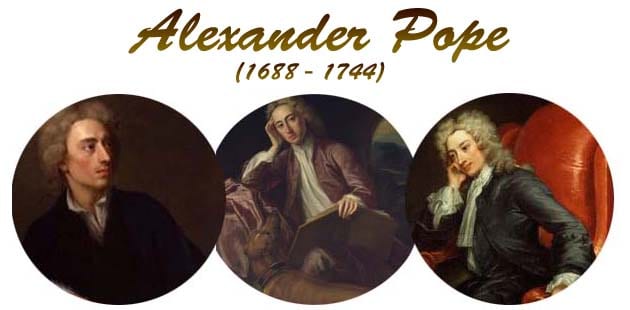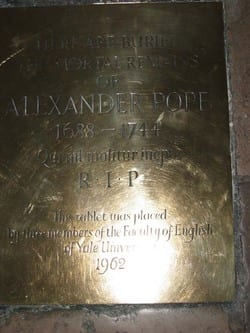
 Biography
Biography
Alexander Pope (1688 – 1744) was an English poet and satirist during the Restoration (“Alexander Pope,” Jokinen). He was born in London on May 21, 1688 into a Roman Catholic family (Jokinen). From childhood, Pope suffered from a spinal deformity that left him disabled and prevented him from ever growing past the height of 4’6″ (“Alexander Pope,” Jokinen). Pope’s formal education was sadly limited because of his religious views (Jokinen). During the Restoration Catholics were persecuted and Pope’s religion prevented him from attending public schools (Jokinen). Despite these limitations, he learned some Latin and Greek from various tutors and became an avid reader and aspired to become a great poet (“Alexander Pope,” Jokinen). He had the advantage of becoming part of a literary subculture among other Roman Catholics living near him (Jonkinen). He was introduced to this circle by Sir William Trumbull and through him he was introduced to important members of the literary community and was accepted among them as a prodigy by age 17 (Jokinen). Pope’s literary career took off when he published his Pastorals in 1709 because they were his first works that were noticed by the public (“Alexander Pope”). Some of his subsequent works include, “An Essay on Criticism” (1711), “The Rape of the Lock” (1712, 1714) and “An Essay on Man” (1733) (“Alexander Pope,” Jokinen). He died at the age of 56 on May 30, 1744 in home at Twickenham (“Alexander Pope,” Jokinen).
 Alexander Pope’s Works
Alexander Pope’s Works
Early Works
Alexander Pope’s literary career began in 1704 and he first attracted public attention in 1709 with his Pastorals (“Alexander Pope”). By this time, Pope was already at work on his more ambitious Essay on Criticism (1711) designed to create a rebirth of the contemporary literary scene (“Alexander Pope”). His next work, The Rape of the Lock (1712) secured his reputation as a poet (“Alexander Pope”). By 1717, an edition of Pope’s collected works was published (“Alexander Pope”).
Translations of Homer
Pope’s translations of Homer (c. 700 B.C.E. ) were his greatest achievements as a translator (Jokinen). “Pope’s translation of Homer’s Iliad was published in six volumes from 1715 to 1720; a translation of the Odyssey followed (1725-1726)” (“Alexander Pope”). When he translated the Odyssey, he worked with two other translators, William Broome and Elijah Fenton who completed half of the translation (Jokinen). Pope’s profit from his translations of Homer was over £8000 (more money than any English author before him had ever made) (Jokinen).
Editorial work
Pope also undertook several editorial projects. One of which was Parnell’s Poems (Jokinen). In 1725, Pope published the works of William Shakespeare (1564–1616) (Jokinen).
 Images
Images

Alexander Pope’s house at Twickenham (above). Pope lived here from 1715 until his death in 1744 (Douglass).


Alexander Pope’s grave. The memorial is in front of the altar and reads: “Here are buried the mortal remains of Alexander Pope, 1688-1744. Qui nil molitur inepte (who wrote nothing inept). R.I.P. This tablet was placed by three members of the Faculty of English of Yale University, 1962.” (left). Pope is buried under the stone marked with the letter “P” (right) (MacFarlaine).
 A short video about Alexander Pope
A short video about Alexander Pope
(Time 5:07)
 Links to e-texts of some of Pope’s works
Links to e-texts of some of Pope’s works
Pastorals (1709)
The Rape of the Lock (1712, 1714)
Essay on Man (1733)
An Essay on Criticism(1711)
The Poetical Works of Alexander Pope: Volume One
The Poetical Works of Alexander Pope: Volume Two
The Iliad of Homer Translated by Alexander Pope (1715-1720)
The Odyssey of Homer Translated by Alexander Pope (1725-1726)
 Works Cited
Works Cited
“Alexander Pope at Old Poetry.” www.oldpoetry.com, Old Poetry, n.d. Web. 20 May 2010.
Dahl, Michael. Alexander Pope. 1727. National Portrait Gallery, London. Web. 20 May 2010.
Douglass, Sara. “Alexander Pope’s House at Twickenham.” www.oldlondonmaps.com, Old London Maps, 2006. Web. 20 May 2010.
Jervas, Charles. Alexander Pope. c. 1713. National Portrait Gallery, London. Web. 22 May 2006.
Jokinen, Anniina. “Life of Alexander Pope.” www.luminarium.org, Luminarium, 2006. Web. 20 May 2010.
MacFarlaine, Ian. “Alexander Pope.” www.findagrave.com, Find A Grave, 2002. Web. 20 May 2010.
Manis, Jim. English Department. Pennsylvania State University. 11 January 2010. Web. 20 May 2010. <http://www2.hn.psu.edu/faculty/jmanis/>
Pope, Alexander. “Pastorals.” www.humanitiesweb.org, Humanities Web, n.d. Web. 20 May 2010.
Richardson, Jonathan. Alexander Pope and His Dog, Bounce. 1718. National Portrait Gallery, London. Web. 20 May 2010.
 Image References
Image References
Pope: top left (Dahl)
Pope: top center (Richardson)
Pope: top right (Jervas)
 Contributors
Contributors
Sara Clark
Jeongmin Kim
Jessica Makdad
Brittany Platzke
Melissa Washkau
Julie Weisman
